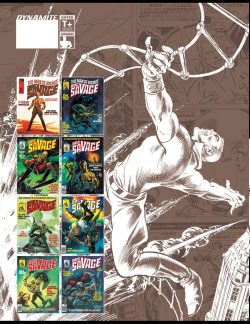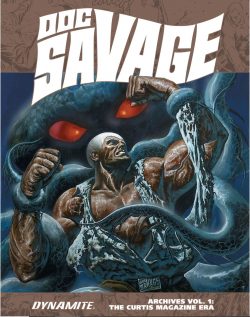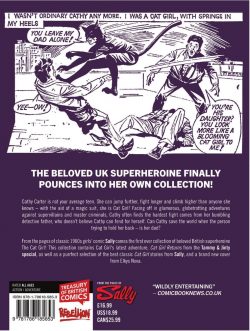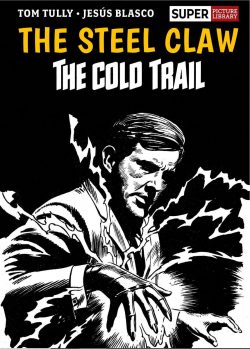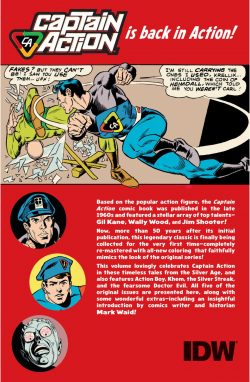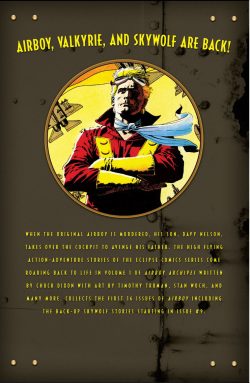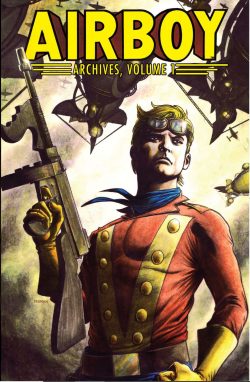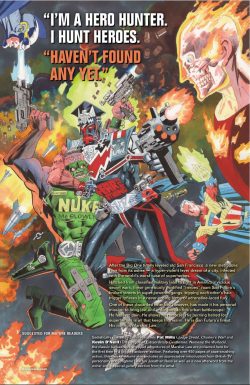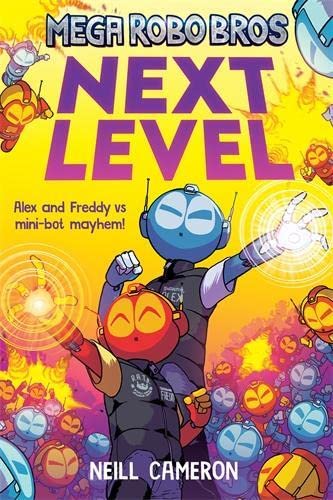
By Neill Cameron, with Abby Bulmer (David Fickling Books)
ISBN: 978-1-78845-294-6 (TPB)
Mighty in metal and potent in plastic, here’s another solid gold all-ages outing from Neill (Tamsin of the Deep, Pirates of Pangea, How to Make Awesome Comics, Freddy) Cameron’s marvellous purpose-built paladins. However, the rambunctious Mega Robo Bros find that even they can’t fight progress adventures and growing pains – in more adventures balancing frantic fun with portents of darker, far more violent days to come…
It’s still the Future!
In a London far cooler than ours, Alex and his younger brother Freddie Sharma are generally typical kids: boisterous, fractious, eternally argumentative yet devoted to each other, and not too bothered that they’re adopted. It’s really no big deal for them that they were meticulously and covertly constructed by the mysterious Dr. Roboticus – before he vanished – and are considered by those in the know as the most powerful – and only fully SENTIENT – robots on Earth.
Dad is just your average old guy who makes lunch and does a bit of writing, but when not being a housewife, Mum is a bit extraordinary, herself – surprisingly famous and renowned robotics boffin Dr. Nita Sharma harbours some shocking secrets of her own…
Life in the Sharma household tries to be pretty normal. Freddie is insufferably exuberant and over-confident, whilst Alex is at the age when self-doubt and anxiety hit hard. Moreover, the household’s other robot rescues can also be problematic…
Programmed as a dog, baby triceratops Trikey is ok, but French-speaking deranged ape Monsieur Gorilla can be mighty confusing, whilst gloomily annoying, existentialist aquatic fowl Stupid Philosophy Penguin hangs around ambushing everyone with quotes from dead philosophers…
The boys have part-time but increasing insistent jobs as super-secret agents, although because they weren’t very good at the clandestine part, almost the entire world knows of them. Generally, however, it’s enough for the digital duo that their parents love them, even though they are a bit more of a handful than most kids. They all live as normal a life as possible: going to human school, playing with human friends and hating homework. It’s all part of their “Mega Robo Routine”, combining dull human activities, actual but rare fun, games-playing, watching TV and constant training in the combat caverns under R.A.I.D. HQ.
Usually, when a situation demands, the boys carry out missions for bossy Baroness Farooq: head of government agency Robotics Analysis Intelligence and Defence. They still believe it’s because they are infinitely smarter and more powerful than the Destroyer Mechs and other man-made minions she usually utilises.
Originally published in UK weekly comic The Phoenix, this revised, retooled and remastered saga opens with the lads feted as global heroes.
After defeating a reject robot rebellion sparked by artificial life activist The Caretaker, the Bros battled monstrous, deadly damaged droid Wolfram and learned that he might be their older brother…
Over the course of that case they learned that fifteen years previously Mum was a young, pretty and brilliant roboticist working under incomparable (but weird) pioneering genius Dr. Leon Robertus. whose astounding advances had earned him the unwelcome nickname Dr. Roboticus. Maybe that was what started pushing him away from humanity…
After months, Robertus to let her repurpose his individually superpowered prototypes into a rapid-response team for global emergencies. Mum used to be a superhero, leading manmade Rapid Response team The Super Robo Six!
While saving lives with them she first met crusading journalist/future husband Michael Mokeme who proudly took her name when they eventually wed…
Robertus was utterly devoid of human empathy but – intrigued by the team’s acclaim and global acceptance – created a new kind of autonomous robot. Wolfram was more powerful than any other construct, and was equipped with certain foundational directives allowing him to make choices and develop his own systems. He could think, just like Alex and Freddy can! Only, as it transpired, not quite…
When Robertus demoted Nita and made Wolfram leader of a new Super Robo Seven, the result was an even more effective unit, until the day Wolfram’s Three Directives clashed during a time-critical mission. Millions of humans paid the price for his confusion and hesitation…
In the aftermath, R.A.I.D. was formed. They tried to shut down Robertus and decommission Wolfram, but the superbot rejected their judgement, leading to a brutal battle, the robot’s apparent destruction and Roboticus escaping…
As the boys absorbed their “Secret Origins”, Wolfram returned attacking polar restoration project Jötunn Base. It covered many miles and was carefully rebalancing the world’s climate, when Wolfram took it over: reversing the chilling process to burn the Earth and drown humanity…
Alex and Freddy were ordered to stay put and not help by Baroness Farooq, but rebelled. By the time the Bros reached Jötunn Base, Wolfram has already ruthlessly crushed a RAID force led by their friend Agent Susie Nichols. After also failing to stop their determined and utterly unreasonable brother, thoughtful, kind contemplative Alex found a way to defeat – and perhaps, destroy – his wayward older brother and save the world…
Here, the boys are seen adapting to a new normal. Their exploit has made them global superstars and whilst immature Freddy is revelling in all the attention Alex is having trouble adjusting: not just to the notoriety and acclaim, but also the horrifying new power levels he achieved to succeed and also the apparent onset of robot puberty…
A collection of shorter, interlinked exploits, Next Level opens with the turbocharged lads attending another Royal Garden Party at Buckingham Palace. Mum has cleverly dodged the affair, leaving Dad and Grandma policing Stupid Philosophy Penguin and Freddy’s increasingly outrageous behaviour in front of the Queen. Anxious and upset, Alex hides in a spectacularly-appointed toilet and finds the Crown Prince doing likewise. Before long, he’s comparing notes on duty and expectation: sharing his feelings of guilt and grief to perhaps the only other kid on Earth who could be expected to comprehend…
Chapter 2 finds the Bros back at R.A.I.D. HQ, breezing through the usual training programs. To stop Wolfram, the boys had to be upgraded with safety protocols rescinded and they are now almost too powerful. That’s proved the moment they let go against the latest droid weapon and reduce it to more budget-busting spare parts in seconds. That’s when Dr. Sharma’s assistant Zahra Abdikarim has a rather brilliant idea, involving force fields and holograms…
Freddy’s dangerous boredom levels are soon decreased via a training regime that resembles a giant video game…
Another day and another first as Freddy foils an actual bank robbery by an actual exo-suited supervillain and stumbles into an even more insidious crime scheme: copyright infringement!
Whilst grandstanding for the crowds after the bust, the little lout sees a street seller hawking extremely sophisticated robot toy knock-offs of him and his brother. Suspicious and worried, Alex and still-recuperating Agent Susie (working from her hospital bed by telemetric tech) trace the toys to Toymakr Industries and clash with a ruthless narcissistic entrepreneur with no respect for law and life. Not only has he stolen their images and reputations, but also weaponised the little dolls and constructed “upgraded” doppelgangers of the real deal…
Cue huge robot-on-robot carnage…
Chapter 4 takes a more introspective tone as Alex’s PTSD trauma manifests as horrific bad dreams and his parents look into therapy and quickly hit a huge biological snag. Although the boys have literally grown from babies and physically change like humans, they are still mechanical not organic and most counselling strategies just won’t work on them. Thankfully Mum is a genius and finds another way to get Alex the help he so badly needs…
Introspection turns to action when the Bros are called in by the Metropolitan Police to help solve a string of impossible robotics/computer company robberies. With Susie in a tricked-out wheelchair, the boys rapidly uncover a cunning, ludicrous yet deadly scheme by an old foe…
A different kind of crisis manifests next as the Mega Robo Bros experience the dubious joys of camping, on and organised kids-only Outbound Adventure trip. It’s the first time away from home – other than for Earth-saving – for both boys and neither is keen to spend time in a strange camp with boys they don’t know. It’s a life-changing experience for all concerned…
After many close calls, Chapter 7 finally hosts the wedding of Susie Nichols and Zahra Abdikarim, but of course the brides’ big day acts as a magnet for chaos and one particular old enemy. Happily, Baroness Farooq is astoundingly adept at anticipating any possible contingency and the Bros are delighted to hand out a hearty hammering to the party crasher in the bombastic feelgood final chapter…
Crafted by Cameron and colouring assistant Abby Bulmer, this rip-roaring riot isn’t quite over yet: offering charming activity pages on ‘How To Draw Cuddle-Bots!’ and ‘How To Panda’ (both Cute and Angry!), as well as delivering a whacky brace of Bonus Comic! capers with ‘Monsieur Gorilla in Les Vacances de M. Gorilla’ before Alex & Freddy play ‘Legend of Heroes’ with catastrophic results…
Exceedingly engaging excitement and hearty hilarity is balanced here with poignant moments of insecurity and introspection, affording g thrills, chills, warmth, wit and incredible verve. Alex and Freddy are utterly authentic kids, irrespective of their origins, and their antics strike exactly the right balance of future shock, family fun and superhero action to capture readers’ hearts and minds. What movies these tales would make!
Text and illustrations © Neill Cameron 2023. All rights reserved.
Mega Robo Bros Next Level will be released on May 4th 2023 and is available for pre-order now.

